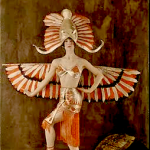This platform is a work in progress matching the state of advancement of the opera Cave 3.0 all along its making until the last scheduled performance. Afterwards, in line with Spanda’s Musiké project to preserve and conserve the ethnomusicological heritage, of which this work is a part, the platform will be turned into an Open Access educational repository. Cave 3.0 is an endeavour aligned with the UNESCO programme for the safeguard of the intangible cultural heritage (ICH).
*
Cave 3.0 is a contemporary multidisciplinary opera in 2 acts, Prelude, 7 scenes, and Epilogue, integrating live performance and holograms in an innovative theatrical language. It is a production depicting the creation and development of human consciousness as perceived and narrated throughout different epics around the world. Each of the seven scenes is framed in a geo-cultural thematic area, portraying a distinct tier of the development of consciousness in each chosen culture, at times addressing and referring to archetypes drawn from traditional lore and, occasionally, quoting verses clothed into their respective theatrical forms. Cave 3.0 is a unique artistic endeavour in that it integrates live performance and holograms into a new whole advanced theatricality: the stage project combines live performers, music, singers, and dancers alongside hologram imagery as an integral part of the stage language. The use of holograms, combined with live performances, challenges the definition and the boundaries between film and theatre, between matter and antimatter, between sensory perception and illusion and aims to advance both the stage’s aesthetic discourse and its fruition. Cave 3.0 aims to create an innovative operatic language using the most advanced technology and stage production to share the most ancient and deeply-rooted human myths. {open} The Meta-narrative unfolds on the vault of the upper section of the Venue/Cave cupola of figure 2, that is to say, on the 3 highest levels of consciousness of the sevenfold paradigm.
The Meta-narrative unfolds on the vault of the upper section of the Venue/Cave cupola of figure 2, that is to say, on the 3 highest levels of consciousness of the sevenfold paradigm.
The Theoretical Framework
The evolution of human consciousness, and of civilisation can be set, to the effect of this context, into seven successive stages as outlined below4, even though it is never safe to expect an exact parallelism between different paradigms portraying the evolution of human consciousness.1 ~ Material stage/phase. Monodimensional, contracted consciousness; egocentric. Archaic; magic era. At individual/identity level, pre-reflexive consciousness, no self-differentiation, the self-identifies with external stimuli, and is projected in material objects; unconscious fusion of self and world, lack of ethical discernment and of the faculty of choice, the being relies on instinct; the path to enlightenment is via the illumination of thought; spiritual development can be communicated by spoken words and can be followed. At social/historic level, roughly 500,000 years ago, the human population consists of unrelated tribal egocentric units, with blood and kinship relations as their major relationship form; cognition is pre-operational, imbued with fantasy and magic; when tribes come in contact there is war, and the taking of the other tribe as slaves. Keywords: sensory world, instinct, sensation, sense of property, power, quantity, insensitiveness, fear, anxiety. Element earth.
2 ~ Vegetal stage/phase. Bidimensional, surface consciousness; consciousness of bodily sensations, egocentric. Hunter-gatherers; magic-mythic era. At individual/identity level, identity is associated with physical existence; emotional reaction to the environment; no distinct sense of time or causality, the immediacy of life experience; the path to enlightenment is via the feelings; emotional illumination. At social/historic level, roughly 35,000 years ago, humanity reaches a distinct capacity for self-reflective consciousness; perceptions are limited, the social organisation is on a tribal scale, life is centred on gathering and hunting existence; matrilineal cultures, nature is perceived as intensely alive and filled with mysterious forces; magic rituals. Keywords: emotions, dualism, pride, selfishness, devotion. Element water, symbolic of feelings.
3 ~ Animal sage/phase. Depth consciousness; ethnocentric. Agrarian-based civilizations; mythic era.
At individual/identity level, awareness, not self-awareness; more complex cognitive function, concrete operational; conscious of feelings; sexual differentiation; exclusiveness; the self takes the role of the other, expands its primary identity to a group(s), from egocentric to ethnocentric, based on race, color, sex, creed, etc. bound by a common belief, a set of rules and laws; religiosity, authority; capacity of imagination, empathy; illumination via the intellect. At social/historic level, roughly 10,000 years ago human perception expands to include a new sense of time embracing nature’s seasons and cycles; emergence of farming consciousness; ritual observance, conformity to the group; magic is transferred from the self to supernatural mythic beings, gods and goddesses and elemental spirits who perform it. Around 3,500 B.C., development of systematic agriculture, food surplus and formation of great cities; development of basic arts of civilization, writing; great religions, the priestly class, patriarchy, division of labour, city-state governments, massive architecture, nations, empires; traditional civilisations, magic-mythic warrior cultures. Keywords: loyalty, group, cognition, ritual, fighter, challenger, warrior. Element fire.
4 ~ Human sage/phase – it embeds a dual nature: a) ephemeral physical vessel; dynamic consciousness. Scientific-industrial modern era; b) spiritual content: reflective consciousness. Communication-technological era. At individual/identity level, self-centric; thinking-based sense of the self, existential ego, self-conscious; identification with the intellect; resurrection and eternity as article of faith, self-purification, individual dignity; spiritual loyalty displaces that of blood and relinquish family ties, alone wandering; strong feminine element; illuminated mind transcends thought through inner vision. At social/historic level, the emergence of the capacity to take the 3rd-person perspective; primary identity from ethnocentric to world-centric (all-humans centred), transpersonal consciousness; think in global objective and universal manner, striving to treat all people fairly, regardless of race, colour, sex, or creed. Slavery is outlawed in modern-rational society. Around 1400 A.D, culture-wide view – the Renaissance. Around 1700 A.D. nature’s mystery and magic are replaced by science and the analysing intellect – the Enlightenment. The dynamic sense of time with a materialistic view of reality, material progress is the primary focus; modern sciences, technical innovation, mass production, extreme division of labour, global free market economy, massive urban centres, rise of strong nation-states. Keywords: the stage of reason, rational, formal operational, positivism, modernity, achievement, accomplishment, merit, creative thought, self-actualization. Element air.
5 ~ Collective stage/phase. Oceanic consciousness; worldcentric. Post-modern era. At individual/identity level, acquisition of the I, self-knowledge, conscious of consciousness, spiritual potentialities; the next world is actualised in the present; access to higher knowledge, detachment, inner vitality, sense of compassion and awareness of unity of human community, deep bonding, renewed connection with nature, identity embraces observer and observed alike. At social/historic level, around 1960, decline of the rational/business/scientific materialism, emergence of postmodern, worldcentric morality – all people have intrinsic worth, regardless of race, colour, sex, or creed, each one deserves an equal economic and social opportunity; cross-cultural learning; human rights, integrity of global environment, shared vision and implementation of sustainable development; globalisation; conversation on how to deal with the intertwined system of problems threatening collective future; system thinking; social system allows both ethnocentric and egocentric stages, social Darwinism, local-to-global communication. Keywords: intuitive mind, self-integration, bodhisattvas, community, bonding, human rights, green movement, civil rights movement, environmental and sustainability movement, personal and professional feminism. Element aether (quintessence/akasha).
6 ~ Compassionate stage/phase. Flow consciousness; worldcentric. Post-ideological era. At individual/identity level, cosmic evolution, transcendence, knowledge of its own evolution, power beyond personal state; new level of human creativity, dynamic creative impulse, exteriorised awareness through all levels of existence; cosmic process experienced as continuously arising, the eternal Now; experience of the self before the world of forms, aliveness and eternal nature of the being; permanent connection with the source; overmind. At social/historic level, strong bonding in the global community, sustainability of the planet, planetary civilisation balance of creativity and diversity. Keywords: compassion, sense of the present, awareness, unity, mindfulness, sustainability.
7 ~ Creative stage/phase. Integral consciousness; cosmicentric. Post-conceptual, post-metaphysical, planetary era. At individual/identity level, awareness of the sacred aspect of creation, understanding of the mysteries of genesis; ever-present origin, self-organising self-remembering identity; wisdom, creativity, and compassion to sustain the future; participation in cosmic scale evolution, one’s own being experienced as existing beyond the world of forms and of not being other than the entire world in continual becoming; completion of the process of development and foundation for a new beginning; the human being has completed and attained all that is possible to attain in its present condition. At social/historic level, 4th-person perspective, capacity to reflect on, and critically analyse global productions; species-civilization. Keywords: ultimate realm, awakening; transcendence and immanence at once, being and becoming are one; the human is one with the spirit, the foundation of all levels; spiritualisation of matter; end of the collective purification stage; unbound to vikarma; formation of the diamond body of resurrection.
- Material. Monodimensional, contracted consciousness. Archaic; magic era.
- Vegetal. Bidimensional, surface consciousness. Hunter-gatherers; magic-mythic era.
- Animal. Depth consciousness. Agrarian-based civilisations; mythic era.
- Human – it has a dual nature: a) physical vessel, and b) spiritual content.
- Dynamic consciousness. Scientific-industrial modern era.
- Reflective consciousness. Communication-technological era.
- Collective. Oceanic consciousness. Post-modern era.
- Compassionate. Flow consciousness. Post-ideological era.
- Creative. Integral consciousness. Post-conceptual, post-metaphysical planetary era.
- South Asia – India: Hinduism, Buddhism, Tantra, Kathakali;
- Southeast Asia – Indonesia: Sufism, wayang, silat;
- Eastern Asia – Japan: Zen, Nôh, Butoh;
- West Africa – Nigeria: Yoruba, Ifá, Egungun;
- Northeast Africa & Middle East – Israel, Turkey, Syria: Kabbalah, Hasidism, hora, Deka; Sufism, darkish, tatbir, Naqqâli.
- Southeast Europe – Greece: Ancient Greece, mythology, Eleusis, tragedy;
- South Europe – Italy, Spain: Fedeli d’amore, Commedia dell’ Arte, Opera, duende, flamenco.





